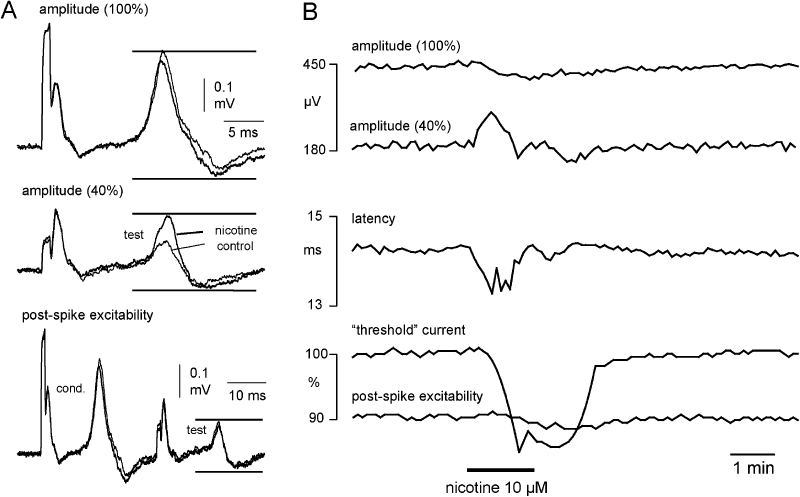Figure 2.

The effect of nicotine on unmyelinated axons in segments of human nerve is illustrated by representative examples of compound action potentials (CAPs) evoked by each of the three stimuli used in the stimulus paradigm to monitor excitability. To monitor the entire population (100%) of unmyelinated axons activated by electrical stimulation the peak-to-peak amplitude of the C-fibre CAP response to supra-maximal stimulation was monitored (A and B, upper trace). Amplitude was taken as the difference between the maximum and minimum excursions of the recorded signal within the time window indicated by upper and lower horizontal bars. The current (duration 1 ms) required to maintain a compound C-fibre action potential amplitude at 40% of the CAP evoked by supra-maximal stimulation (100%) was the second parameter monitored (A, middle trace). This parameter is used to monitor changes in the electrical activation threshold of the unmyelinated C-fibre population (‘threshold current’). To assess post-spike excitability, the current required to maintain a CAP amplitude at 40% of the supra-maximal response was monitored at a fixed delay of 30 ms after a preceding CAP of maximal amplitude had been evoked (A, lower trace). Each of these parameters was monitored sequentially at 2 s intervals during the recording period. (B) Upon application of nicotine (10 µM) the amplitude of the 40% CAP increases, that is, nicotine has an excitatory effect. The tracking software reduces the current ‘threshold’ (B, lower panel) to maintain the 40% amplitude. In addition, the normal post-spike super-excitability that follows an action potential is reversed to sub-excitability in the presence of nicotine, which is consistent with nicotine depolarizing the axons.
